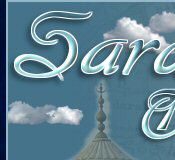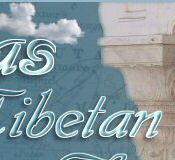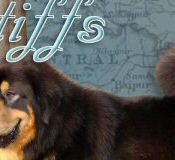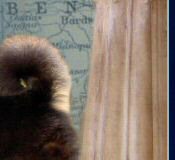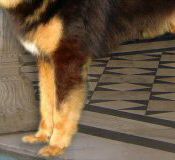|
The above links will lead you to learn more about the Tibetan
Mastiff. The introductory write-up gives a brief overview of what
to expect of the breed and the Standard gives more detailed information
concerning structure, temperament and specific characteristics.
Further, you will discover a little about the history of the TM
and, finally, an interesting comparative chart of the Tibetan Mastiff
(also known as the Dokhyi) and the Himalayan Sheep Dog or Gaddi.

Introduction
Country of Origin:
Tibet.
General Appearance:
The overall picture created is that of a large, powerful dog,
sturdily built and well-balanced with short legs, if compared to
the body. His expression is alert and noble. The thick, heavily-feathered
tail is carried high over the back, nicely balancing the head.
The body is square with a distinctive double coat and a proudly
worn ruff around the neck and shoulders extending to the occiput.
Head is outstanding and massive with a powerfull and heavy muzzle
which is squarish from all angles and flat from when seen from
above.
Temperament:
Each Tibetan Mastiff has its own personality, but generally, the
Tibetan Mastiff is very protective brave, loyal. and territorial
dog. Its temperament is excellent with children of own family and
Good with other pets if properly introduced.
Health:
Normally a healthy breed.
Adaptability:
Excellent. One of the most highly adaptable breed of the world,
can adapt to extreme climatic conditions hot or cold.
Guarding Potential:
Excellent. The Tibetan Mastiff is known for being a night-time
barker, and has a booming voice. This can be a problem in packed
neighborhoods. More mature dogs can develop restraint, but getting
to that point can take a deal of patience. This is one area where
a Tibetan Mastiff's stubbornness can defeat even the most determined
owner.
Amount of Exercise:
Moderate. Jogging is too hard on the joints due to the breed's
size. Be careful that the bones, muscles, and joints of the young
dog are not overworked during the growing stage by overdoing physical
exercise. It should never be over-exercised.
Amount of Grooming:
It should be brushed regularly. Give bath a few times per year
only when very necessary.
Coat Type:
Body is covered with an undercoat of soft, short, dense wool with
longer and harsher hair growing through it to form the outer coat.
Hair are fine but hard, straight and stand-off. Never silky, curly
or wavy. Heavy undercoat, when present, rather woolly.
Intelligence:
Highly Intelligent but Aloof.
Trainability:
Average (Not a dog for Obedience Shows)
Dominance:
Dominating breed.
Urban Living:
Not recommended for apartments.
Outdoor Living:
Excellent.
Size:
Dogs minimum 26" (66 cm).
Bitches minimum 24" (61 cm).

Our Views & What We Breed For
The General Appearance of the Tibetan Mastiff:
The Tibetan Mastiff is a large guardian breed and should present
as strong and substantial, muscular and athletic, balanced and
impressive. The Tibetan Mastiff head is a distinguishing characteristic
of the breed and the most outstanding feature. It must be broad,
powerful and expressive. The muzzle should be thickly padded with
a clearly defined stop and is in direct proportion with the head.
The prominent occiput should also be clearly defined. Eyes are
almond-shaped. Forelegs should be strong and straight with slight
angulation of pasterns. Rears legs should be moderately angulated
with well let down hocks. Fore and rear legs, as well as neck and
tail should be furnished with longer guard coat. Tail is to be
carried over the back or hip and should create a balanced picture
when viewed from the side. Proportions are slightly longer than
tall.
Colour:
The Tibetan Mastiff should not be of light colour as shades of
cream, or light goldens, and should have minimum of white markings.
Both being treated as faults. Permissible colours are darker shades
of gold, black and tan, and shades of gray.
Coat:
Coat should be thick and dense with a heavy undercoat in winter.
Quality of coat has greater importance than quantity.
The Tibetan Mastiff & It's Sub-breeds:
Geographically, India shares her place on the map with her adjoining
neighbouring countries of Tibet, Nepal and China and her long border
extends from Jammu and Kashmir to Himachal Pradesh to Uttar Pradesh,
now some parts known as Uttranchal to the Eastern Border States
of India ( ie. Arunachal Pradesh, Assam etc). It was along these
areas that Tibetan Mastiffs were bred to the regional/local dogs
resulting in varied SUB-BREEDS. The variation in type includes
features, size and colour and these main differences usually diverge
in direct accordance to the specific region in which the Tibetan
Mastiff was bred.
In Jammu and Kashmir the Tibetan Mastiff sub-breed is known as
BAKARWAL DOGS. These dogs routinely have their ears cropped and
overall size is somewhat smaller than the parent breed of TIBETAN
MASTIFFS. These dogs are basically used as herding dogs for sheep
and cattle and are extremely ferocious normally.
In Himachal Pradesh, the Tibetan Mastiffs were again bred to the
regional dogs and the outcome is the sub-breed known as GADDI DOGS.
These dogs are very large, high on their legs and may or may not
have the typical outstanding head of a Tibetan Mastiff. They may
have light colours and more white markings as compared to the requisite
of the minimal white and darker colours of the Tibetan Mastiff.
Used by nomads these dogs are primarily used for herding purposes
and secondarily as watchdogs.
Previously a part of Uttar Pradesh, Uttranchal the sub-breed here
is known as the BHOTIA. These dogs are very similar to the parent
breed of TIBETAN MASTIFF. Size and bone are comparable to the Tibetan
Mastiff with the only major differences being with colour, head
and muzzle. The muzzle of the BHOTIA is not as heavy and substantial
as that of a Tibetan Mastiff and the coat colour may tend to lighter
shades of cream with more white markings.
The above SUB-BREEDS have originated from the TIBETAN MASTIFFS.
It is of importance to note that as the genes go back to the parent
breed of the Tibetan Masiff, they do tend, at times, to produce
the parent breed of the Tibetan Mastiff!!!
Some who read the foregoing paragraphs may find them to be contentious
but my opinions and beliefs are based on personal experience and
my involvement with the Tibetan Mastiff breed extending back over
two decades. I also draw upon my personal observation, factual
information, knowledge of the history of the dogs in the mentioned
areas along with the exchange of shared information with other
TM breeders, owners and enthusiasts the world over that included
Gp.Capt A. J. S. GREWAL, Mr.TENZING NORGAY, and Mr. P. S. SHANDILIYA,
a noted K.C.I. Judge and TM breeder.
With very best regards,
Himmat Singh Sekhon

Standard

General Appearance :
The overall picture created is that of a large, powerful dog,
sturdily built and well-balanced His expression is alert and noble.
The thick, heavily-feathered tail is carried high over the back,
nicely balancing the head. The body is square with a distinctive
double coat and a proudly worn ruff around the neck and shoulders
extending to the occiput. Hair on the head is soft, silky and smooth.
Characteristics:
He is a courageous dog with strong protective instincts. He has
spirit, initiative and courage, with no trace of timidity although
he does take the time to size up a situation before acting. The
Tibetan Mastiff possesses an excellent memory, is intelligent and
easily trained, faithful, gentle with children and obedient. Although
aloof with strangers, he has a desire to please and is a good-natured
family companion, playful on invitation and generally impressive
by his dignity upon reaching maturity.
Structure:
The Tibetan Mastiff is a strong substantial animal with a heavy
frame possessing the structure and configuration to provide stamina,
speed and agility. He should never be so heavy as to appear coarse
or clumsy nor so slight as to appear racy.
Temperament:
Aloof and protective.
Skull:
Skull massive, with strongly defined occiput and stop. The crown
somewhat arched when viewed from the side, with a well-developed
or pronounced occiput and definite sloping stop. Slight median
line extending back over the forehead. There is a definite furrow
extending from the stop to halfway up the skull which becomes a
ridge and extends to the occiput. Fairly broad, heavy and strong. Proportions
from occiput to stop and stop to end of nose equal, but nose may
be a little shorter.
Head:
The head is perhaps the most notable feature of the Tibetan Mastiff. Head
and shoulders must look substantial with a thick ruff, square and
well-cushioned muzzle. Some wrinkling, in maturity, on head,
extends from above eyes, down to corner of mouth. The beauty of
the head is emphasized by chiseling along the muzzle, around and
beneath the eyes.
Nose and Muzzle :
Muzzle fairly broad, well filled and square, viewed from all
sides; wide and blunt and well-cushioned when viewed from the front.
Neither coarse nor snippy. Broad nose, well pigmented, well opened
nostrils. Lips well developed with moderate flews. Muzzle is equal
to 2/3 length of crown from stop to occiput. Clean cut, powerful
and square in shape. The muzzle must have depth when viewed from
the side.
Nose and lips black. Wide with well-developed nostrils. Upper
lips pendulous. Lip line should not have the appearance of being
coarse nor should the flews drop prominently at the corners of
the mouth. Jaws strong and muscular, although the female's jaws
may be lighter. Strong, well-set teeth, snugly overlapping in a
tight scissor bite or level. Undershot and overshot bites are undesirable.
Eyes:
Very expressive, medium size, any shade of brown. Very bright,
almond shaped, well-spaced with lower lid slanting upwards toward
an imaginary point approximately at the base of the ears. Round
or protruding eyes penalized. Set obliquely under moderately prominent
supraorbital ridges. Eye rims black.
Ears:
Medium size, triangular, pendant, tips rounded, carried low,
dropping forward and hanging close to head. Raised when alert.
Ear leathers covered with soft, short hair. When pulled forward,
the tip of the ear reaches the inner corner of the eye on the same
side. In the relaxed position, ears should hold their set and not
cast backward. Leather is covered with short soft hair.
Mouth:
Scissor bite. Jaws strong, with perfect, regular and complete
scissor bite, i.e., upper teeth closely overlapping the lower teeth
and set square to the jaws. Level acceptable. Essential that dentition
fits tightly, to maintain square form of muzzle.
Neck:
Strong, well muscled, should slope to withers giving the impression
of strength and dignity. Dog exhibits a pronounced crest of the
neck when at attention. The neck gradually increases in circumference
as it approaches the shoulder. Moderate dewlap in mature dogs,
more pronounced in males. Not too much dewlap. Shrouded by thick
upstanding mane.
Shoulders:
Should lie close to the body, long and moderately sloping, well-muscled
without being coarse. Reach well up to point of withers.
Chest:
Deep and of medium width with pronounced sternum, ribs well sprung
out from spine and flattened at the sides to allow proper movement
of the shoulders and freedom from the front legs. Heart and lung
room are secured more by body depth than width.
Topline:
In the following descriptions the anatomical components of the
spinal column have been described separately, i.e. withers, back,
loin and croup.
- Withers - Slope onto a level back.
- Back - Straight, short and very strongly developed without
sag or roach.
- Loin - When viewed from top, broad and muscular. Loin slopes
slightly upward to moderately pronounced hips. Loin is taut and
broad, although narrower than rib cage and with moderate tuck-up.
Ratio of back to loin is approximately 1:2.
- Croup - Must be full, slightly sloping but never so steep as
to restrict rear movement and must continue imperceptibly to
the tail root.
Tail:
Moderately long. Profusely feathered with thick, long hair and
carried forward in a plume over the back. Sometimes dropped at
rest. Judges should see tail up at least once.
Body:
Strong, with straight back, muscular, almost imperceptible croup.
Chest rather deep of moderate breadth, with reasonable spring of
rib, to give heart-shaped ribcage, brisket reaching to below elbows.
Body slightly longer than height at withers.
Forequarters:
Well laid shoulders, muscular, strongly boned. Straight legs
with strong, slightly sloping pasterns, and well covered all over
with strong hair. The pasterns should be strong, sturdy and slightly
sloping to give flexibility and spring for proper let-down of feet.
The slope should not start at the joint but below it. The slope
should always be sufficient to bring the heel of the pad under
the center of gravity. Length of leg from ground to elbow should
be 50-55% of total height at withers. A very short-legged dog is
to be penalized.
Hindquarters:
Powerful, muscular, with good angulations from well bent stifle
and strong low set hocks. Two thirds of rear leg is between hock
and hip. Upper thighs well-developed and slightly bowed from
hock to crotch. As endurance is of greater consequence than speed,
the stifle is slightly bent. Hind legs, seen from behind, parallel.
Removal of dewclaws (single or double) optional.
Feet:
Fairly large, strong, compact. Cat-feet having good feathering
between toes. The second and third digits may be relatively longer
but the foot should lose none of its compactness. The forefeet
are larger than the hind feet, toes arched, pads thick and tough.
Gait/Movement:
Should be free, agile and vigorous, showing great elasticity
and spring in the smooth, powerful stride. When walking appears
slow and very deliberate. From the standing position, as the Tibetan
Mastiff moves the pads converge to a single track beneath the actual
center of the dog. The marked single track gait of a well-built
Tibetan Mastiff should never be mistaken for the gait fault of "moving
close". The Tibetan Mastiff works at a canter and often uses
the double suspension gallop. He must be sure of foot in any kind
of going. Ability to turn quickly and initial spring are desirable
qualities. Moving with head and tail held high, the whole appearance
of the Tibetan Mastiff is one of great style, grace and beauty.
Coat:
Body is covered with an undercoat of soft, short, dense wool
with longer and harsher hair growing through it to form the outer
coat. The coat texture is heavy around the neck, shoulders and
down the back to the tail. Coat on legs, side and stomach is shorter
in length and somewhat lighter
in texture. It is that heavy texture of the neck and shoulders
that gives the impression of a lion's mane. Tail bushy, densely
coated, hind legs well feathered on upper rear parts. Males carry
noticeably more than females. Quality of greater importance than
quantity. Mainly fairly long, thick, with heavy undercoat in cold
weather which becomes rather sparse in warmer months. Hair fine
but hard, straight and stand-off. Never silky, curly or wavy. Heavy
undercoat, when present, rather woolly. When in full coat, undercoat
should be so dense as to make it almost impossible to see skin.
Height:
Dogs : 66cms (26 ins) minimum. Bitches : 61 cms (24 ins).
Faults:
A dog with an uncontrollable or vicious temperament in the ring
should be disqualified by judge. Overall shaggy coat, lack of symmetry
and balance in movement, well-bent stifles, barrel legs or pigeon
toes, mincing, shuffling, crabbing, weaving or a hackney action
are all faults.
Disqualification:
Male animals not have two apparently normal testicles fully descended
into the scrotum.

History
 The
Tibetan Mastiff is considered to be one of the oldest breeds in
existence today. However as accurate written records were not kept
much of the earlier history is unknown. As early as the 13th century,
Marco Polo told of seeing these Mastiffs in his Far East wanderings.
Some believe they were used as guard dogs in China from 1000 BC.
This is a breed which has remained unchanged for thousands of years
as proved by bones unearthed from different eras, and from pictures
as well. The
Tibetan Mastiff is considered to be one of the oldest breeds in
existence today. However as accurate written records were not kept
much of the earlier history is unknown. As early as the 13th century,
Marco Polo told of seeing these Mastiffs in his Far East wanderings.
Some believe they were used as guard dogs in China from 1000 BC.
This is a breed which has remained unchanged for thousands of years
as proved by bones unearthed from different eras, and from pictures
as well.
The Tibetan Mastiff is a descendant of the famous Tibetan dogs
that were the source of the majority of Molossuses and Mastiffs
throughout the world. The ancient Tibetan Mastiff may have been
in existence as early as the stone or bronze age. Mollossian dogs
accompanied Alexander the Great from Tibet to Europe, and during
this period helped to found many of today's other Mastiff breeds.
Tibet later closed its doors to western world, thus the breed
developed for centuries in relative isolation. In the mid 1800's,
a Tibetan Mastiff was presented to Queen Victoria of England. Later
on more dogs were imported to England and the British began to
refine and standardize the breed.

Tibetan Mastiff vs. Gaddi
Tibetan
Mastiff (Dokhyi)

|
Himalayan Sheep
Dog (Gaddi)

|
General Appearance:
Heavy squarish built with not too long legs, almost short
compared to the body, heavy boned short thick neck with thick
mane like coat. |
General Appearance:
Heavy boned may have long legs. |
Head:
Broad, massive, outstanding head with strongly defined occiput
and stop. |
Head:
Does not require an outstanding head. |
Muzzle:
Powerful, strong squarish muzzle which is never long thin
and pointed. Very well defined stop. |
Muzzle:
Muzzle is not squarish and is pointed, long and thin and
stop is not very prominent. |
Neck:
Strong thick and powerful mane like neck. |
Neck:
May be thin or thick. |
Coat:
Heavy thick and course with dense woolly undercoat . Medium
in length should not be very long, neither flessy, silky
nor wavy. Males carry noticeably more than females. Quality
of greater importance than quantity. |
Coat:
May be short or long, curly or wavy. |
Color and Markings:
Colours are 'black & tan', 'golden red', 'shades of
brown, grey and gold' White is permissible only on the chest.
Darker colours are preferred. |
Color and Markings:
No restriction of colour or white markings. |
Tail:
Feathered, bushy, medium to long but not reaching below
hock joint in length carried curled over the back. |
Tail:
Hairy tail carried same way as the TM but the length may
be longer than the TM. |
Paws:
Compact, large strong paws. |
Paws:
May have loose paws. |
|
